“Now as he was going along and approaching Damascus, suddenly
a light from heaven flashed around him. He fell to the ground and heard a voice
saying to him, ‘Saul, Saul, why do you persecute me?’”
(Acts 9.3-4)
I have been hoping to find the time to follow the footsteps of St.
Paul, and travel to the city of Damascus at some point during my stay in the
region. Mainly I have wanted to visit Sister Tabitha in Damascus, a Syrian
Orthodox nun who received the Scholarship of St. Basil the Great in 2002 (as I
have now, in 2006) making it possible for
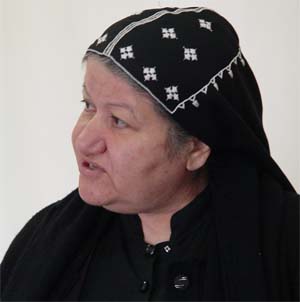 her to live for a year in Toronto with our Anglican Sisters of St.
John the Divine and to audit classes at Wycliffe College, Toronto School of
Theology.
her to live for a year in Toronto with our Anglican Sisters of St.
John the Divine and to audit classes at Wycliffe College, Toronto School of
Theology.
It finally became possible to make the trip this week, and on Wednesday I joined three of Sr. Tabitha’s Syrian Orthodox sisters for a charter taxi trip to Damascus. They had been visiting their convent here for a few days and were returning home to Damascus. It turns out that their convent is not much more than a stone’s throw from the Armenian seminary … I’ve discovered that, from my window at the seminary, I can see the convent, the neighbouring orphanage operated by the community, and a new Syrian Orthodox church they are building on the same site!
We travel in a fairly new passenger van, and the ride takes about 3 hours and
costs 800 Syrian Pounds ($16 USD) per person, each way. Wa’al, the driver of the
taxi, picks me up around noon at the Catholicosate and we stop at Bikfaya to
collect the three sisters — one of whom is the Mother Superior of the entire
community. Following tea — Mother insists on the formalities of welcoming a
visitor in the Middle East — we take our places in the van, and drive off over
the mountains towards Damascus. Pictured here, Wa’al, Mother Superior and the
two sisters traveling with her (centre) and the two sisters based in Bikfaya
(right).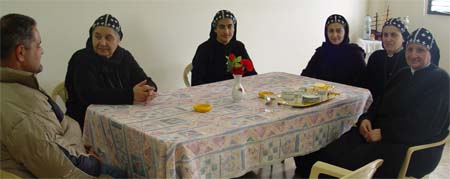
Wa’al is a Syrian Christian. He tells me (in French) that he makes the journey between Damascus and Beirut about once a day, twice during the summer. He and his brother, who share duties driving the family owned taxi, live near the Syrian Orthodox Patriarchate that I will be visiting. I learn later that driving is a prominent occupation among Christian men in Wa’al’s part of Syria. So much so, that there’s a joke that goes, “The neighbours have a new baby.” “That’s great, is it a girl or a taxi driver?”
In any case Wa’al is a very good driver, and the going is anything
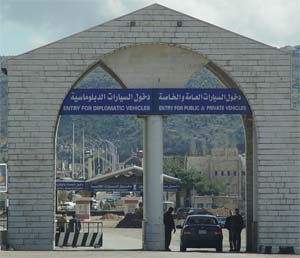 but easy with thick fog (in and out of
clouds), a narrow road, and twists and turns very much of the hair-pin variety.
After about an hour, the road drops down to the wide Bekka valley, a rich and
fertile plateau between the central mountains of Lebanon and the high ridge that
marks the border with Syria.
but easy with thick fog (in and out of
clouds), a narrow road, and twists and turns very much of the hair-pin variety.
After about an hour, the road drops down to the wide Bekka valley, a rich and
fertile plateau between the central mountains of Lebanon and the high ridge that
marks the border with Syria.
We arrive at the border about 2 hours after our departure, and it is a definite advantage having someone as experienced as Wa’al to guide me through the border crossing … “Follow me, but let me do the talking.” And everything goes very smoothly. In fact, it could be said that it’s actually easier to drive into Syria from Lebanon than it is, now, to drive from Canada into the USA!
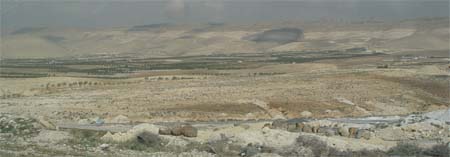
The change in scenery, as we drop down from the border crossing to the great Syrian plain, is dramatic, to say the least. (The picture above is taken from Syria looking west towards the ridge along the border — no sign of Lebanese cedar here!) Wa’al takes the ring road around to the north of Damascus heading for the Christian enclave of Ma’arat Sayyidnaya, a suburb of the city and the new location of the Syrian Orthodox Patriarchate. It’s a bit strange to see that we are travelling, as a road sign suggest, on aroute that also leads to Baghdad — albeit about 12 hours away!
The new Patriarchate is the crowning achievement in the long reign of his Holiness Ignatius Zakka I Iwas, Patriarch of Antioch. His Holiness only recently celebrated his 25th jubilee as Patriarch; and he is a much respected figure in the Christian world today. Among other things, he is considered the living successor of St. Peter, founder of the Church in Antioch — where followers of “the Way” were first called Christians (Acts 11.26).
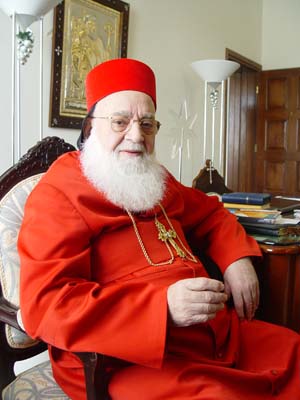 His Holiness is known as a deeply
spiritual and caring man; and I must say it was a great honour to meet with him
on two occasions during my stay at the Patriarchate. (This picture was taken
on the morning of my departure.) I learn from the monks that his Holiness
rises in the middle of the night to study and pray, going to bed again following
matins, and rising a few hours later for a long day attending to his many and
various duties — for the most part, welcoming a continuous flow of visitors —
usually doing so well into the evening. He is very much a spiritual father, much
beloved by his people.
His Holiness is known as a deeply
spiritual and caring man; and I must say it was a great honour to meet with him
on two occasions during my stay at the Patriarchate. (This picture was taken
on the morning of my departure.) I learn from the monks that his Holiness
rises in the middle of the night to study and pray, going to bed again following
matins, and rising a few hours later for a long day attending to his many and
various duties — for the most part, welcoming a continuous flow of visitors —
usually doing so well into the evening. He is very much a spiritual father, much
beloved by his people.
There are many reasons why the Patriarchal see of Antioch is now based in Damascus, not least of which, the persecution of the Syrian Orthodox along with the Armenians and other Christian groups in Turkey at the beginning of the last century. After many stops along the way — including a time in Zahlé, Lebanon — the Patriarchate finally settled in Old Damascus in 1959. By the mid-1980s the Syrian Orthodox Patriarchate had outgown the space available to them in the old city and his Holiness acquired the land for the new patriarchate in the predominantly Christian community of Ma’arat Sayyidnaya — and the work of transfering the institutions of the Patriarchate from Old Damascus began.

The seminary, pictured centre above, opened its doors in 1996, and a new cathedral (right), a convent for the sisters, a conference centre, and a large auditorium (left) were completed in subsequent years.
We arrive at the new convent at the Patriarchate around 3 p.m. and Sr.
Tabitha comes over from her work at the seminary to greet us. We have time for
another round of tea and a short visit before going over to join the seminarians
and the Syrian monastic community for vespers. This picture of the sisters
and some of the monks, was taken following the vespers service. Sr Tabitha is on
left.
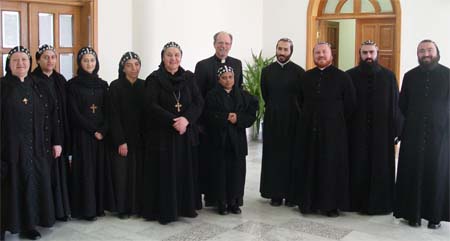
Like the Armenians, the monks and seminarians are organised in their new chapel for the chanting of the offices in two groups singing “antiphonally” (from side to side.) The great early father of the Christian church, St. Ignatius, the third Patriarch of Antioch, introduced the custom of including readings in Christian worship from the Hebrew scriptures and from the writings of the Apostles (in his day, this included only a few texts, the beginning of the collection of what would eventually become the New Testament.)

Through the ages, the descendants of St. Ignatius have gathered to chant and pray around two lecturns, with a third, reserved solely for the Gospel in the centre. The Syriac language used in the worship of Syrian Orthodoxy is only slightly different from the Aramaic that was the mother tongue of Jesus of Nazareth. (Perhaps as different as is contemporary English from the mother tongue of one William Shakespeare.) The chants have a distinctly middle-eastern texture and are wonderful to hear, as you can discover for yourself (though the recording does not do justice to the singing) by clicking here to listen to a Syrian Orthodox vesper chant.







